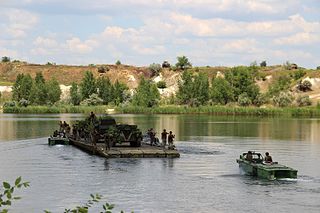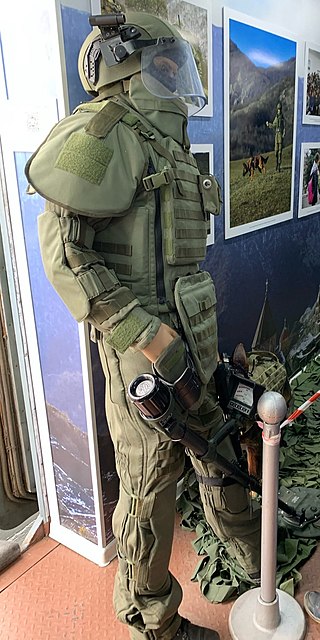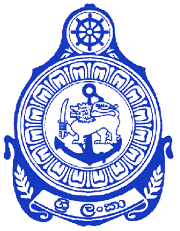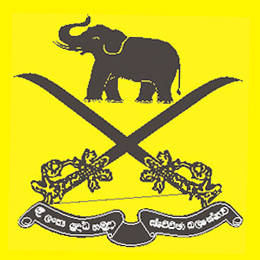
Military engineering is loosely defined as the art, science, and practice of designing and building military works and maintaining lines of military transport and military communications. Military engineers are also responsible for logistics behind military tactics. Modern military engineering differs from civil engineering. In the 20th and 21st centuries, military engineering also includes CBRN defense and other engineering disciplines such as mechanical and electrical engineering techniques.

A sapper, also called a combat engineer, is a combatant or soldier who performs a variety of military engineering duties, such as breaching fortifications, demolitions, bridge-building, laying or clearing minefields, preparing field defenses, and road and airfield construction and repair.
A mine clearance organization, or demining organization, is an organization involved in the removal of landmines and unexploded ordnance (UXO) for military, humanitarian, or commercial reasons. Demining includes mine clearance, as well as surveying, mapping and marking of hazardous areas.

The Sri Lanka Navy (SLN) is the naval arm of the Sri Lanka Armed Forces and is classed as the country's most vital defence force due to its island geography and is responsible for the maritime defence of the Sri Lankan nation and its interests. The role of the Sri Lanka Navy is to conduct operations at sea for the defence of the nation and its interests and conduct prompt and sustainable combat operations at sea in accordance with the national policies.

The Sri Lanka Army is the oldest and largest of the Sri Lanka Armed Forces. The army was officialy established as the Ceylon Army in 1949, though the army traces it's roots back in 1881 when Ceylon Light Infantry Volunteers was created; the army was renamed as the 'Sri Lanka Army' when Sri Lanka became a republic in 1972. In 2024, the Army had approximately 150,000 personnel.

The Sri Lanka Air Force is the air arm and the youngest of the Sri Lanka Armed Forces. It was founded in 1951 as the Royal Ceylon Air Force (RCyAF) with the assistance of the Royal Air Force (RAF). The SLAF played a major role throughout the Sri Lankan Civil War. The SLAF operates more than 160 aircraft.

The Sri Lankan Armed Forces award medals and their associated ribbon bars in recognition of various levels of service, personal accomplishments and commemorative events while a regular- or volunteer serviceperson is a member of the Sri Lanka Army, Sri Lanka Navy and the Sri Lanka Air Force. Together with military badges, such awards are a means to outwardly display the highlights of a serviceperson's career.

The Regiment Special Force (RSF) is a Sri Lanka Air Forces elite special force unit, which is part of the SLAF Regiment. It was raised in 2006.The RSF Wing is an independent formation of the SLAF and commanded by a Commanding Officer who is responsible to the Commander of the Air Force through Director Ground Operations for the efficient and effective function.

The Sri Lanka Armoured Corps (SLAC) provides the armour capability of the Sri Lanka Army, with vehicles such as the T-55AM2, and type 80/88 main battle tanks; the BMP infantry fighting vehicle; and the BTR-80, and WZ551 armoured personnel carriers. It comprises five regular armoured regiments, a volunteer regiment, and a regimental band. It has an independent Armoured Brigade and is headquartered at Rock House Army Camp, Colombo.

The Sri Lanka Artillery (SLA) is the artillery arm of the Sri Lanka Army. It is made up of ten regular regiments and two volunteer regiments. The SLA is headquartered at Panagoda Cantonment, Panagoda.

The Corp of Sri Lanka Engineers (SLE) is a combat support arm of the Sri Lanka Army which provides military engineering. It is made up of ten regular regiments and one volunteer regiment. Headquartered at Panagoda Cantonment, it is headed by the Centre Commandant.

The Sri Lanka Army Volunteer Force (SLAVF) is the active-duty volunteer reserve force of the Sri Lanka Army. The SLAVF is separate from the Regular Force which consists of personal who are professional soldiers and its Regular Reserve, which comprises personal who have a mobilization obligation following their service in the regular army. The SLAVF consists of the volunteer force and the volunteer reserve; administration and recruitment of reserve personal is carried out by the Volunteer Force Headquarters in Shalawa, Kosgama which is headed by the Commandant of the Volunteer Force. It has a current strength of about 55,000 personnel. The SLAVF was known as the Ceylon Volunteer Force from 1949 to 1972 and the Sri Lanka Volunteer Force from 1972 to 1985.

General Deshamanya Joseph Everard Denis Perera, VSV, FCMI was a senior Sri Lanka Army general who served as Commander of the Sri Lankan Army from 1977 to 1981. He was also the Sri Lankan High Commissioner to Australia, Chairman of the Securities and Exchange Commission and the Ceylon Tobacco Company and Chancellor of General Sir John Kotelawala Defence University. He envisioned for a women's corps in the army which resulted in the creation of the Sri Lanka Army Women's Corps in 1979.

General Ganegoda Appuhamelage Don Granville Nalin Seneviratne, VSV was a Sri Lankan Army general. He was the Commander of the Sri Lankan Army from 1985 to 1988 and first Governor of the North East Province.

The Sri Lanka Armed Forces is the overall unified military of the Democratic Socialist Republic of Sri Lanka encompassing the Sri Lanka Army, the Sri Lanka Navy, and the Sri Lanka Air Force; they are governed by the Ministry of Defence (MoD). The three services have around 346,700 active personnel; conscription has never been imposed in Sri Lanka. As of 2021 it is the 14th largest military in the world, with 1.46% of the Sri Lankan population actively serving.
The Diyatalawa Garrison is a common name used for collection of military bases of the Sri Lanka Army located in and around the garrison town Diyatalawa in the Uva Province. Sometimes it is referred to as the Diyatalawa Cantonment. It is one of the oldest military garrisons in Sri Lanka. It is home to the several training centers of the army, including the Sri Lanka Military Academy and has a detachment of the Gemunu Watch. The Sri Lanka Army Medical Corps maintains a base hospital in Diyatalawa. SLAF Diyatalawa is situated in close proximity.
Vice Admiral Hikkaduwage Ananda Silva, VSV was a Sri Lankan senior naval officer who was the 11th Commander of the Sri Lankan Navy.

General Akurathiya Withanage Jagath Crishanthe de Silva, RWP, USP is a former senior Sri Lanka Army general and military engineer. He had served as the Commander of the Sri Lanka Army from 22 February 2015 to 4 July 2017, as the Chief of Defence Staff from 29 June 2017 to 21 August 2017. Later he was appointed as the Sri Lankan High Commissioner to Bangladesh.
Major General Jagath Gunawardena, RSP, VSV, USP was a Sri Lankan senior army general. He was the Chief of Staff of the Sri Lankan Army, having served as the Commandant of the Volunteer Force, Commander, Security Forces Headquarters – Wanni and Master General of Ordnance. He served as the Colonel Commandant of the Sri Lanka Engineers.
14 CBRN Regiment, Sri Lanka Engineers is a regiment of the Sri Lanka Army that focuses on countering chemical, biological, radiological and nuclear (CBRN) hazards in the country. The Sri Lanka Navy and Sri Lanka Air Force also maintain CBRN units in addition to the Army's CBRN regiment. The regiment evolved from the first CBRN squadron that Major General Jagath Gunawardena, the current colonel-commandant of Sri Lanka Engineers, established.














